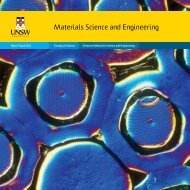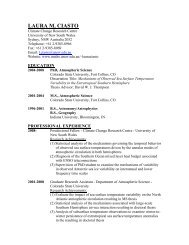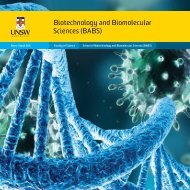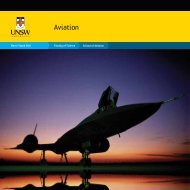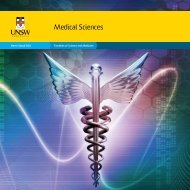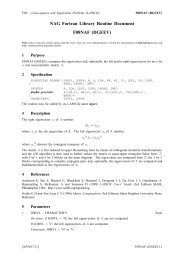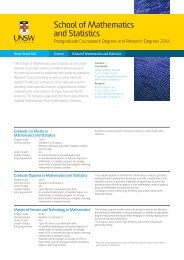2011 Postgraduate Research Competition - UNSW Science - The ...
2011 Postgraduate Research Competition - UNSW Science - The ...
2011 Postgraduate Research Competition - UNSW Science - The ...
Create successful ePaper yourself
Turn your PDF publications into a flip-book with our unique Google optimized e-Paper software.
Page |36<br />
What is your contact lens storage case<br />
Yvonne Wu and Fiona Stapleton<br />
School of Optometry & Vision <strong>Science</strong><br />
Abstract<br />
<strong>The</strong>re are 125 million contact lens users worldwide. Epidemiological studies have confirmed<br />
that poor contact lens case hygiene may cause microbial keratitis, a sight-threatening<br />
condition. However, there are limited data on how to clean contact lens cases. This study<br />
experimentally evaluated and compared the effectiveness of various cleaning procedures in<br />
removing biofilm from contact lens cases, hoping to provide lens case hygiene guidelines for<br />
lens wearers, practitioners and the industry.<br />
Bacterial biofilms were formed on lens cases. Each lens case was then subjected to one of<br />
the following cleaning methods: rinsing with disinfecting solution, rubbing with fingers, wiping<br />
with tissues, air-drying for 6 hours, and recapping lids for 6 hours. <strong>The</strong> residual bacteria after<br />
each cleaning procedure was quantified. <strong>The</strong> most effective cleaning procedures that were<br />
then tested sequentially.<br />
Air-drying and recapping the lids had no effect in removing biofilm (p>0.9). Rinsing with<br />
solution elicited a marginal anti-bacterial action. Rubbing lens cases and wiping with tissues<br />
were the most efficient, and these two cleaning methods combined provided the optimum<br />
results (p



